How To Breed Mules In Minecraft
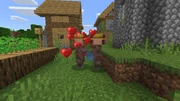
Ii villagers breeding.

A wolf pup with its parents.
Breeding is a game mechanic that allows mobs of the same species to breed with each other to produce offspring (with the exception of breeding a mule, which requires a horse and donkey).
Mechanics [ ]
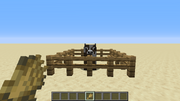
A cow following the thespian.
Each animal that can be bred has a nutrient particular used to pb and breed it (in that location are a few special cases, described below). Once an fauna notices a player holding its food, it follows the player until either the player is out of range, the role player stops holding the item, it begins the breeding process, or it is attacked. This includes baby animals. Note that animals are uninterested in food lying on the ground. Ane item per parent is needed to breed a single baby.
Love fashion [ ]
When an beast is fed its food, it enters "love mode", preparing to brood with another beast of the same species that is as well in dearest fashion. Animals that are in love mode emit heart particles constantly. When both animals are fed, they pathfind toward each other, up to eight blocks abroad. The two animals kiss for about two and a half seconds, and then a baby fauna of the same species spawns either in betwixt the parents or in the aforementioned position every bit the parent that was spawned first, ending love fashion for the parents. Convenance likewise drops 1–7. The parents do not eat breeding items for 5 minutes, afterwards which feeding them once over again causes them to enter dearest mode. However, they yet follow players holding breeding items, equally does the baby. An animal exits dearest mode if it does not breed 30 seconds subsequently existence fed; however, information technology immediately becomes able to exist fed and enter love style again.
Different other animals, mules can not be bred this fashion. Convenance a mule requires a matrimony between a horse and a ass.
Breeding foods [ ]
| Mob | Items | Other | ||||
|---|---|---|---|---|---|---|
|
| The following can also be used for growing a baby horse or donkey, and for healing:
| ||||
|
| Sheep can abound faster if they eat grass . | ||||
| Grunter |
| |||||
| Chicken |
| |||||
| Wolf (Tamed) |
| Tamed wolves must exist at full health before being fed to breed. They must be fed to restore HP. Meat cannot be used to tame a wolf. Only bones can be used to tame wolves. In Bedrock Edition, the following can besides be used for healing, simply cannot be used for breeding nor growing a baby wolf:
| ||||
|
| Tamed cats must exist at total health before being fed to breed. They must be fed to restore HP. Ocelots besides trust players. | ||||
| Axolotl |
|
| ||||
|
| The following can besides exist used for growing a baby llama, and for healing:
| ||||
| Rabbit |
| |||||
| Turtle |
| Dissimilar other mobs, turtles do not have the babies immediately, instead they lay eggs that take a few days to hatch. | ||||
| Panda |
| To breed requires 8 bamboo at radius of 5 blocks. | ||||
| Fox |
| The infant play a joke on always trusts the histrion and does non run abroad when approached. | ||||
| Bee |
| All one-block-tall and two-block-alpine flowers work, including wither roses. Feeding bees wither roses gives them the Wither effect and does not anger them. | ||||
| Strider |
| Crimson fungi practise not piece of work. | ||||
| Hoglin |
| Breeding hoglins with warped fungi does not work, equally hoglins are repelled by them. | ||||
| Frog |
| Like turtles, frogs do not accept the babies immediately, instead they lay eggs that take a few days to hatch. |
Villagers [ ]
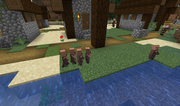
A group of villager children playing tag.
Villagers do not breed automatically when given nutrient. Villager convenance depends on both the number of valid beds in the area (come across the hamlet folio for full details), as well as whether the villagers are "willing." A villager may become willing if they take iii staff of life, 12 carrots, 12 potatoes, or 12 beetroots in their inventory. They may besides get willing as a issue of trading with a player. When they brood, they produce a smaller villager. Unlike many baby animals, infant villagers do non take big heads in Java Edition. Baby villagers run around the hamlet, and tin can "play" tag. A baby villager killed past a zombie may get a baby zombie villager, depending on difficulty.
Breeding formula [ ]
A histrion may want to know the number of mobs required in a farm to accomplish a certain goal, for example: to make a total-powered enchanting table with bookshelves (46 leather needed) or for total leather armor (24 leather), in case the actor has a cow farm. In that location is a formula to summate how many mobs are needed in a farm, past the starting number and if the player waits until all the mobs become mature (this does not apply to villagers):
where is the number of mobs at generation , and is the floor() performance.
When using larger values of north, it may exist easier to approximate the number of mobs using an exponential function to avert doing too many recursive calculations:
where the input is the n-th generation and the output is the gauge number of mobs after breeding. The constant is Euler's number.
Alternatively, if the player starts with mobs and wants to reach a population of at least , it tin can exist achieved in generations, where is the ceil() performance.
Babe mobs [ ]
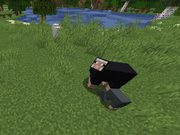
An example of how a bred sheep inherits a mixture of its parents' colors when possible.
Except for baby frogs, infant animals are smaller variations of their parents, having small bodies, relatively big heads, and faster walking speeds. Their sounds are the same as their developed variants but l% faster and are pitched up by 6 semitones. Lambs cannot be sheared for their wool, chicks do non lay eggs, calves and mooshroom calves cannot be milked, and horses, mules, donkey foals, piglets and stridlings cannot be saddled or ridden. They do not drib loot or experience if killed (excluding baby zombies and their variants).
Except for baby rabbits[1], wild wolf pups, ocelot kittens, devious kittens, and infant turtles[2] and tadpoles, about baby animals (in Java Edition) and except for tadpoles almost all babe animals (in Boulder Edition) cull and follow an adult within 8 blocks of the aforementioned species, regardless of whether information technology is their parent. Babies tin can choose new targets to follow whenever they don't have a valid target, such as when the previous target dies or moves further than 16 blocks away. Tamed pups and kittens follow their possessor if the parent is absent or sitting, and pups attack aggressive mobs merely every bit a mature wolf would.
When lambs are born, they ordinarily inherit the color of i of their parents, chosen at random. However, if the parents have "compatible" colors (meaning that their corresponding dye items could be combined into a third dye), the lamb inherits a mix of the parents' colors (see Dye). This holds even if one or both of the parents have just been sheared before breeding and have not nevertheless grown their coats back. In Boulder Edition, however, lambs do non inherit the combined colors of their parents.
Baby animals can be manually spawned by using spawn eggs on a grown animal. This too works on zombies or variants.
Infant animals may also exist spawned using the /summon command with a negative Age tag; for case, using /summon sheep ~ ~ ~ {Age:-100} spawns a infant sheep at the player'southward position, that matures in 100 ticks (five seconds). For baby mobs that don't grow upward like zombies and piglins, the IsBaby:1 tag is used instead.
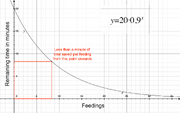
Feed graphic for baby animals.
Infant animals take 20 minutes to abound up. This can be accelerated by feeding them their breeding particular. Greenish sparkles appear similar to those caused past bone meal. Each feeding reduces the remaining fourth dimension before the animal grows upwards by 10%. The less fourth dimension remains, the less time is saved by each feeding, making information technology inefficient to feed an creature continuously until information technology becomes an adult. After the ninth feeding, the time saved by ane feeding is less than a minute, as shown in the graph. Horses, donkeys, and llamas accept dissimilar mechanics: different convenance items grow babies by different amounts, and each item ages babies by a constant time rather than a percentage of the remaining time.
Infant undead mobs and baby piglins cannot be bred and never abound upwardly. Babe polar bears (cubs) can grow up, but cannot be bred, and growth fourth dimension cannot be accelerated.
Baby hoglin is considered a monster in Java Edition, but it is considered an animal in Boulder Edition. This is because hoglin and baby hoglin are counted toward monster mob cap in Java Edition, while in Bedrock Edition, they are counted toward creature mob cap, despite its hostile nature.
Animals [ ]
All of these mobs are considered animals, equally the majority of them are existent-life animals. The majority of these mobs can exist created when their parents have entered beloved mode afterwards being fed.
Monsters [ ]
Any baby mob that counts toward the "Monster Hunter" and "Monsters Hunted" advancements or are simply undead is considered a monster and belongs here. Out of all these monsters, only hoglins tin be bred, and can grow up into its adult form. The remainder of these infant monsters cannot be bred and never grow up.
Other [ ]
Villagers are produced from convenance, but practice non count as animals or monsters.
Achievements [ ]
| Icon | Achievement | In-game description | Bodily requirements (if different) | Gamerscore earned | Trophy blazon (PS4) | |
|---|---|---|---|---|---|---|
| PS4 | Other platforms | |||||
| Repopulation | Breed ii cows with wheat. | Breed 2 cows or 2 mooshrooms. | 15G | Bronze | ||
| Zoologist | Breed two pandas with bamboo. | — | 40G | Golden | ||
Advancements [ ]
| Icon | Advancement | In-game description | Parent | Bodily requirements (if unlike) | Resource location |
|---|---|---|---|---|---|
 | The Parrots and the Bats | Brood two animals together | Husbandry | Breed a pair of whatsoever of these 23 mobs:
| husbandry/breed_an_animal |
 | Ii by 2 | Brood all the animals! | The Parrots and the Bats | Breed a pair of each of these 22 mobs:
| husbandry/bred_all_animals |
History [ ]
| Java Edition | |||||
|---|---|---|---|---|---|
| 1.0.0 | September nine, 2011 | Jeb tweets that brute breeding is pushed to i.9. | |||
| September 25, 2011 | Notch also tweets an image of dozens of sheep crowded together, saying "They won't stop breeding!!!" | ||||
| Beta i.9 Prerelease two | Introduced convenance. Animals could breed instantly, without any "cooldown". | ||||
| No infant animals yet; all animals were built-in fully-grown. | |||||
| All sheep were born with white wool, irrespective of their parentage. | |||||
| October 3, 2011 | Notch tweets the first image of a cow calf and piglet. | ||||
| Beta 1.9 Prerelease 2 | Snow golems can enter dearest mode using wheat. | ||||
| Beta i.9 Prerelease 3 | Added calves, mooshroom calves, lambs, piglets, and chicks. | ||||
| Animals now enter "love mode" when fed with wheat. | |||||
| Interestingly, snowfall golems could also enter love mode before this update. | |||||
| Beta 1.9 Prerelease 5 | Baby animals now work in multiplayer.[ more data needed ] | ||||
| Beta ane.9 Prerelease 6 | Lambs tin can exist either of their parents' colors, fifty-fifty if they were dyed. | ||||
| ane.two.one | 12w03a | Wolves can be bred with any type of meat to produce pups. | |||
| 12w04a | Cats (tamed ocelots) tin now be bred with raw fish for kittens. | ||||
| 12w08a | Baby villagers and kittens are now the just babe mobs that have a head the correct size for the body. | ||||
| 1.three.i | 12w22a | Breeding now give experience. | |||
| 1.4.2 | 12w32a | Zombies that infect villager children now create zombie villager children, which are faster than normal zombies, practice non age, and survive in sunlight. | |||
| 12w36a | Pigs are now responsive to carrots, chickens to seeds, with cows and sheep still breeding with wheat. | ||||
| ane.six.1 | 13w16a | Added horses, donkeys, and mules, all of which except mules tin can breed to produce foals. | |||
| 1.6.2 | pre | Zombie and zombie pigmen children now spawn naturally among regular ones. | |||
| 1.viii | 14w02a | Baby mobs can be grown faster by being fed. Each feeding reduces the remaining time to maturity past x%, having no effect if less than ix seconds remain. 28 feedings reduce the remaining time to around a infinitesimal, from the initial time of 20 minutes. In addition, lambs reach maturity one minute sooner for every time they consume grass. | |||
| January 27, 2014 | Dinnerbone tweets an image of many cows, presumably testing the convenance arrangement. | ||||
| 14w26c | Wheat's dispatch of foals growth has been reduced. | ||||
| 14w27a | Added rabbits, which tin exist bred to produce rabbit kits. | ||||
| pre1 | Chickens can no longer be bred using melon seeds, pumpkin seeds or nether wart. | ||||
| 1.9 | 15w31a | Chickens now apply melon seeds, pumpkin seeds and beetroot seeds to breed, in add-on to wheat seeds. | |||
| 15w35a | Zombie villager children now retain their profession. | ||||
| 15w46a | Rabbit kits are now smaller. | ||||
| one.10 | 16w20a | Added polar bears and cubs. Unlike other mobs, polar bears attack any player, if a cub is nearby. | |||
| Added husks and children. | |||||
| 1.xi | 16w39a | Added llamas and crias. | |||
| 1.13 | 18w07a | Added turtles and turtle hatchlings. | |||
| 18w10d | Zombie children now burn down in daylight. | ||||
| i.14 | 18w43a | Added pandas and panda cubs. | |||
| 18w44a | Cats and ocelots accept been split into their own mobs, thus cats are no longer tamed ocelots. | ||||
| Added seven more true cat textures and their kitten variants. | |||||
| 19w07a | Added foxes and play tricks kits. | ||||
| 1.15 | 19w34a | Added bees and bee larvae. | |||
| 1.16 | 20w06a | Added hoglins. | |||
| 20w07a | Added hoglin piglets. | ||||
| Added piglins and piglin children. | |||||
| 20w13a | Added striders and stridlings. | ||||
| 20w14a | Added zoglins and zoglin piglets. | ||||
| 1.17 | 20w51a | Added axolotls and axolotl juveniles. | |||
| 21w13a | Added goats and kids. | ||||
| 1.19 | 22w11a | Added frogs and tadpoles. | |||
| Pocket Edition Alpha | |||||
| v0.6.0 | Introduced baby animals. Breeding has not been added yet. Babies naturally spawn. | ||||
| v0.8.0 | build 2 | Introduced breeding. | |||
| v0.xi.0 | build 11 | Mobs must be touching to breed (previously they could breed with whatever mob in an eight block radius, regardless of obstruction). | |||
| Added Zombie children. | |||||
| v0.12.1 | build one | Villagers can now breed. | |||
| Convenance is at present done through a Feed button. | |||||
| Added zombie villager children. | |||||
| Added ocelot kittens and tamed kittens. | |||||
| v0.thirteen.0 | build 1 | Added rabbits, which can be bred to produce kits. | |||
| v0.14.0 | build 1 | Infant zombies at present take 15% adventure to mountain mobs. | |||
| v0.15.0 | build 1 | Added husks, including their baby form. | |||
| Added horses, donkeys, and mules, all of which can brood to produce foals (except mules). | |||||
| Added zombie horses and skeleton horses, which include foal variants. | |||||
| Pocket Edition | |||||
| 1.0.0 | alpha 0.17.0.1 | Added polar bears and cubs. Unlike other mobs, polar bears assault whatever player if a cub is nearby. | |||
| 1.i.0 | alpha 1.one.0.0 | Added llamas and crias. | |||
| Bedrock Edition | |||||
| i.4.0 | beta 1.two.xiii.viii | Added drowned and their kid variants. | |||
| beta 1.two.20.1 | Added dolphins, which tin be bred to produce dolphin calves. | ||||
| Zombie children now fire in daylight. | |||||
| 1.five.0 | beta 1.v.0.0 | Zombie children now sink underwater. | |||
| Feeding dolphins raw fish no longer breed them; dolphin calves at present spawn naturally. | |||||
| beta 1.5.0.4 | Added turtles and turtle hatchling. | ||||
| 1.8.0 | beta one.8.0.viii | Added pandas and their cubs. | |||
| Feeding ocelots now breed them, instead of taming them. | |||||
| Feeding an ocelot kitten raw fish now increment its growth speed, instead of taming it. | |||||
| 1.thirteen.0 | beta 1.13.0.i | Added foxes and fob kits. | |||
| 1.fourteen.0 | beta one.fourteen.0.1 | Added bees and bee larvae. | |||
| 1.16.0 | beta 1.16.0.51 | Added piglins and hoglin piglets. | |||
| Added piglins and their child counterparts. | |||||
| beta one.16.0.57 | Added zoglins and zoglin piglets. | ||||
| Added striders and stridlists. | |||||
| 1.sixteen.200 | beta 1.sixteen.200.52 | Added goats and kids. | |||
| Legacy Console Edition | |||||
| TU7 | CU1 | i.0 | Patch 1 | Added breeding. | |
| TU11 | Added a message when the player tries to breed an animal when the spawn limits have been reached. | ||||
| TU12 | Added Villager children. | ||||
| TU14 | 1.04 | Infant mobs tin now be spawned by using | |||
Issues [ ]
Bug relating to "Breeding" are maintained on the issues tracker. Report issues at that place.
Trivia [ ]
- Any two adult animals of the same species can breed with each other, even if one brute is the parent of the other.
- Baby squid and baby dolphins exist in Bedrock Edition, even though they cannot exist bred by the player.
Gallery [ ]
-

Early on image of sheep breeding.
-

Early paradigm of baby animals.
See also [ ]
- Tutorials/Animal farming
References [ ]
- ↑ MC-158608 – resolved as "Works as intended"
- ↑ MC-185516
How To Breed Mules In Minecraft,
Source: https://minecraft.fandom.com/wiki/Breeding
Posted by: watkinsaromese.blogspot.com


 is the number of mobs at generation
is the number of mobs at generation  , and
, and  is the
is the 
 is Euler's number.
is Euler's number.  mobs and wants to reach a population of at least
mobs and wants to reach a population of at least  , it tin can exist achieved in
, it tin can exist achieved in  generations, where
generations, where  is the
is the 


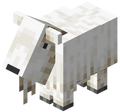

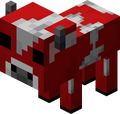




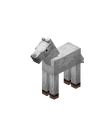
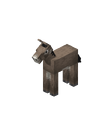
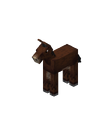




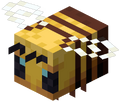



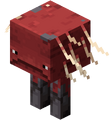
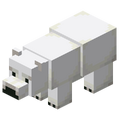


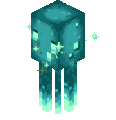
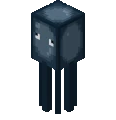






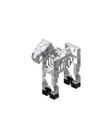
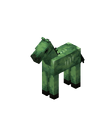


0 Response to "How To Breed Mules In Minecraft"
Post a Comment